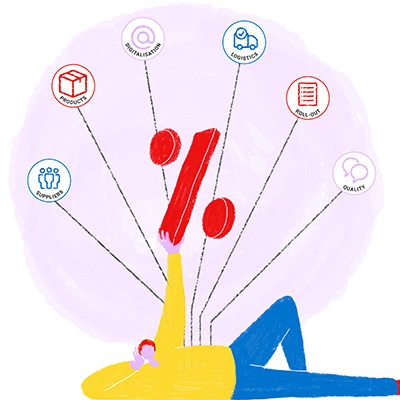Businesses are in constant pursuit of performance, combining resource optimisation, operational efficiency and productivity. Like all other functions, procurement departments are no exception. They want to save time, make informed decisions, whilst maintaining control over costs and risks. It is in this context that procurement digitalisation and process automation take on their full meaning. Particularly as 50 to 70% of tasks are potentially automatable within procurement departments, according to McKinsey consulting firm.
E-procurement solutions
The first automation tools favoured by procurement teams are e-procurement solutions. They enable the digitisation of procurement processes across the three main phases of the Procure-to-Pay process (P2P): product selection, order sending, and invoicing and payment management. Throughout the process, a number of tasks can be automated: integration of the procurement request into the information system, validation workflow, matching of purchase orders and invoices...
This accelerates purchasing processes, reduces manual errors, and optimises the total cost of acquisition of goods or services. And for good reason: transactional costs can be reduced by up to 80%! Lastly, this contributes to improving overall team satisfaction: simplified product search for internal customers, reduced accounting processing, simplified management for buyers...
|
E-procurement with Manutan We provide you with various solutions to digitise your transactional processes. Thanks to our experts and our technical solution, we connect to a large share of marketplaces within the shortest timeframe. We adapt to all situations, whether you are equipped with an external platform or an in-house solution. Don't have e-procurement solutions yet? We implement a webshop for your company. |
AP automation
To go further in invoice automation, companies can also rely on AP Automation (Accounts Payable Automation). These tools enable invoice digitalisation, but also automation of supplier invoice processing, from data capture to payment. These solutions rely on various technologies such as Electronic Data Interchange (EDI), Optical Character Recognition (OCR) or machine learning.
The first notable advantage of these supplier accounting automation systems is time-saving. According to Generix Group, companies are able to accelerate their invoice processing by around 80%. Not to mention that this helps reduce errors and costs, as well as improve traceability. This is the key to invoice flow management that is both fluid, controlled and efficient.
Procurement chatbots
Generative AI opens the way to massive use of enhanced chatbots in daily operations. These conversational agents transform into intelligent virtual assistants, serving buyers. They can help them in many tasks: processing routine requests with suppliers, searching and sharing key information to support decision-making, data collection and analytics...
Pascal Bensoussan, Chief Product Officer at Ivalua, believes in the potential of autonomous agents for process automation: "Imagine that a user needs to replace a broken part in a machine. The user takes a photo of the broken part, and the autonomous agent takes over. It immediately analyses the image, identifies the defective part, finds suppliers capable of replacing it, and launches a tender. It evaluates the proposals received based on several criteria, then selects the best choice. Once the decision is made, it issues a purchase order, updates the contract and negotiates the terms." Depending on the type of procurement, the agent could cover all or part of the purchasing process and integrate human supervision.
Robotic Process Automation
Robotic Process Automation is ideal for automating time-consuming and repetitive tasks. These are procurement automation software robots that execute routine, methodical and standardised processes by following simple rules. This applies, for example, to data entry, information collection, file management... To go further, a new generation of tools can handle more complex procurement processes. Intelligent Process Automation can assist teams with unusual tasks that require thought and discernment.
These RPA software can be deployed within a few weeks, with implementation cost savings. Leslie Willcocks, professor in the management department at London School of Economics, explains: "The main advantage we found in the 16 case studies we conducted is a return on investment ranging between 30 and 200% during the first year. But we must not be satisfied with short-term financial gains, especially if they simply result from labour savings. This approach does not do justice to the power of the software, as the benefits for the company are multiple." By adopting the right tools, procurement teams can thus free themselves from time-consuming and repetitive tasks to focus on more strategic missions.
E-sourcing tools
E-sourcing solutions aim to simplify and improve strategic sourcing activities and procurement procedures. This includes a large part of automation: sending notifications and reminders to buyers, internal customers and suppliers, reports, comparisons and offer analyses according to the established scoring system, pre-formatted responses to stakeholders, online negotiations... All these features contribute to reducing contract award timeframes and enable procurement teams to conduct quality exchanges with suppliers and build high value-added strategies.
Contract Lifecycle Management software
CLM (Contract Lifecycle Management) tools are also very useful for optimising supplier contract management. In addition to centralising documents and strengthening compliance, these solutions automate and streamline contractual processes, from initiation to contract renewal. This also includes the creation, processing, negotiation, execution, and management phases. Contractualisation thus becomes faster, more fluid, and better aligned with company priorities.
Tomorrow, the whole challenge will be to orchestrate all these automation tools. This is what Nick Heinzmann, Head of Research at Zip, highlights: "The future does not lie in adding yet another dashboard or isolated solution. It is rather about true orchestration: a unified and connected experience that actually works across systems, teams and decisions. The next step of this orchestration is to give autonomy to processes, going beyond automation towards AI capable of acting, adapting and advancing procurement. This is how procurement managers get ahead of the chaos."









